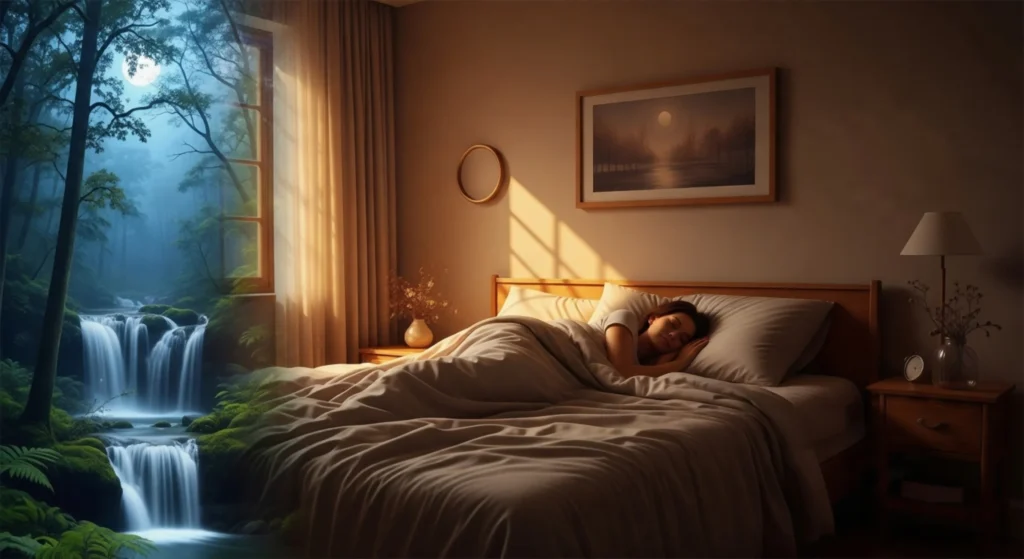Nature Sounds White Noise: Nature Sounds vs. White Noise: 5 best Differences to Combat Insomnia

Introduction
Nature Sounds White Noise — What Can Help with Insomnia?
Insomnia affects about 30% of all adults across the world, causing sleep issues like falling asleep, staying asleep, or waking up too early and feeling unrefreshed [CDC, 2022]. As people become more interested in natural remedies to improve their sleep hygiene, sound therapy has gained popularity. Nature sound and white noise can be found everywhere.
However, if you want to help you fall asleep quicker and stay asleep longer, which one is better? This article will compare nature sound and white noise, focusing on the five most important aspects of these types of sound, using research and some expert advice. Regardless of whether you are a light sleeper, suffer from chronic insomnia, or are just looking for a more pleasant routine at bedtime, you will find important takeaways that can help you decide which sound or sounds work best for your sleep health.
Knowing the differences: What are Nature Sounds White Noise?
Nature Sound is authentic human-made audio recordings of natural sounds, such as rain, ocean waves, wind rustling through the trees, or birds chirping. Natural sounds are designed to resemble natural environments and are often used in mindfulness and sleep routines.
On the other hand, White Noise is a continuous, static-like sound that has all audible frequencies at the same level. Think about the hum of a fan or air conditioning.
Nature Sounds White Noise:
Nature Sounds:
- Nonlinear, soothing, and inconsistent
- Simulate real-world environments (i.e., forest, rainstorm, waterfall)
- Can activate the body’s relaxation response
White Noise:
- Consistent and steady
- Blocks environmental Noise
- Often used to mask disruptive sounds
Instruction Tip:
Try playing both types of sound for 5–10 minutes before going to bed. Notice how your body and mind respond—do you feel more relaxed with a natural stream, or neutral with a steady hum?

Brain Response: How Each Sound Type Affects Sleep Mechanisms
Your brain does not process the same way with sounds. Research indicates that natural sounds can activate the parasympathetic nervous system for relaxation (Annerstedt et al., Scientific Reports, 2013) and lower heart rate.
White noise works by masking disruptive noise. White noise creates a sound barrier that keeps sudden changes in auditory input from awakening you from sleep.
Nature Sounds White Noise:
Nature Sounds: Stimulates
- Stimulates relaxation pathways
- Promotes lower cortisol
- Associated with emotional/mental wellness
White Noise:
- Reduces sleep disruptions by blocking higher-pitched and sharper noises
- Creates some sound uniformity in noisy environments
- Good for those living in apartments or who are light sleepers
Instructional Tip:
Use natural sounds if stress or anxiety is the root cause of your insomnia. Use white noise if environmental sounds (e.g, traffic noise or noises caused by pets) disturb your sleep.
User Preference: What do Sleepers Prefer?
In sleep surveys and real-world practice, people tend to have a stronger emotional response to natural sounds. They associate natural sounds with tranquility and feeling safe, which helps them fall asleep.
White noise tends to feel more clinical. There may be a justification for it, as some users do become desensitized and monotone. Others feel white noise works for sleep but is annoying over time.
Researchers in a 2020 study published in Sleep Medicine Reviews reported that personalized soundscapes (e.g., natural sounds) were more sleep beneficial than general white noise.
Nature Sounds White Noise:
Real example:
Some apps (such as the one included in this sound therapy) can customize sounds that can create different natural elements that users mix into a custom soundscape, providing users with a bit of both.
Instructional Tip:
If you find white noise is disconnecting you energetically, given the clinical/machine quality of the sound, why not try a guided experience of natural sounds? You can choose from an ocean, birds, waterfalls, or the jungle ambiance.

Long-Term Impact on Mental and Physical Health
Natural sounds have been reported to have positive long-term effects on mental and physical health, including reduced anxiety and improved mood and blood pressure. This extends beyond just sleep and is beneficial in a holistic sense.
White noise is neutral in this respect; it helps to support sleep by masking other sounds but does not provide any actual emotional or physiological benefits.
Nature Sounds White Noise:
Nature Sounds:
- Improves sleep and resilience to emotional and physical events
- Decreases overnight stress
- Assists in mindfulness activities
White Noise:
- Only used functionally
- Useful in short periods (e.g., hotels, busy cities)
- May cause dependency for some users
Instructional Note:
Consider using the natural sounds in your morning routine os well! Here is a helpful post on how to engage with natural sounds in a 10-minute morning routine.
Use Cases: When to Use Nature Sounds vs. White Noise
To select between the two sound types, you will have to reflect on your setting, the sleep challenge, and which emotional state you need to regulate.
Nature Sound:
Nature Sounds Work If:
- You feel anxious or restless at bedtime
- You need something more relaxing and, immersive setting
- You value emotional well-being in addition to sleep
When to use White Noise :
- When your sleep is interrupted by unexpected sounds (traffic, snoring, etc.)
- When you need to focus (also good for studying).
- When you are in a shared space that is noisy.
Tip: You can try EZ Calming Sleep, sound generators like this (the Genius Wave) top-rated sound generator that has both white noise and nature tracks with multi-layer audio.
Bonus: If your insomnia is related to lifestyle stress or your exposure to nature is limited, try building wellness routines while using calming plants. We recommend this medicinal seed kit to build a calming indoor space.
FAQs
Q1. Can I mix nature sounds with white noise?
Yes. Some sound apps combine both for a layered audio therapy experience that gets you both calm and consistent in your sound.
Q2. What are the side effects of white noise long term?
White noise is safe for most users, but overuse can make it harder to sleep without it. Make sure to have times when you let your mind rest with the natural silence.
Q3. How long should I play sleep sounds at night?
Most sleep experts suggest playing sleep sounds for a minimum of 30 minutes to 1 hour. However, some people find benefit in leaving the sounds on all night.

Conclusion:
Which Is Better for Insomnia—Nature Sound vs White Noise?
There is value in both natural sound and white noise in sleeping therapies. Natural sounds help to ease stress and nurture lasting mental health, while white noise creates noise masking and sleeping consistency.
If you are seeking deeper emotional rest and a more holistic way of living, then natural sounds are a better choice for the long term. If your top priority is to block out unknown noise, white noise is a more suitable choice.
Nonetheless, whichever you choose, consistency is key! Use the sound consistently with an established bedtime routine and mindful habits to achieve greater results.






